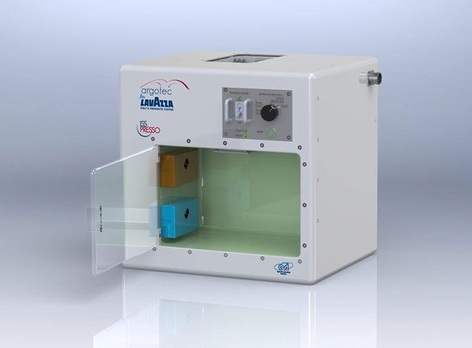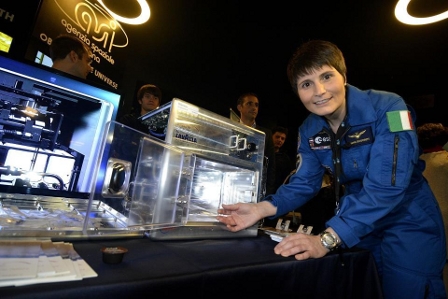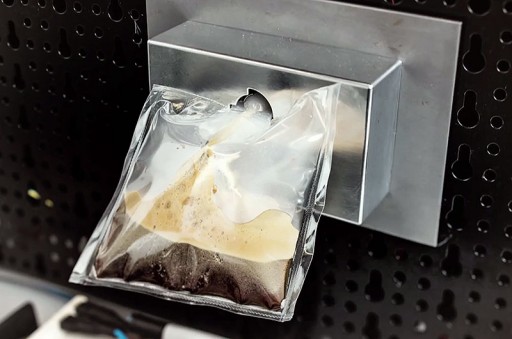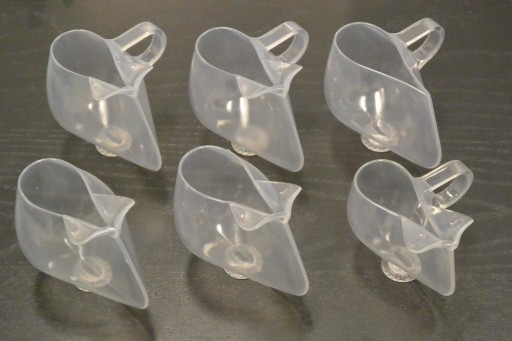ISSpresso

ISSpresso is the first ‘real’ coffee machine headed into space to provide crews with a taste of home. Although humans have been spending extended periods of time in orbit for decades, all that was available in terms of coffee was instant. The ISSpresso payload is a multi-functional device that can be used to brew coffee, but also to make teas, broth and other hot beverages – overall improving the quality of drinks available to ISS crew members. ISSpresso was developed in Italy by Lavazza and Argotec in cooperation with the Italian Space Agency.
Beverages that are available aboard ISS include fruit drinks, tea, cocoa and coffee that fly to ISS as dry powders to limit cargo upmass since every Kilogram of cargo flying to ISS comes at a considerable price. The powders are re-hydrated inside drinking pouches using either cold or hot water provided by the Potable Water Dispenser that delivers purified water to the crew from the Station’s Water Processing Assembly which recycles urine and perspiration to drinking water. Carbonated drinks are not available on the Space Station.
ISSPresso is a capsule-based espresso system that has been specifically built to be able to operate in the microgravity conditions aboard ISS. Not much bigger than a normal espresso maker, the device will be plugged into a standard 120-Volt ISS power outlet. Fresh water is provided to ISSPresso via a standard drink bag that is filled using the USOS Potable Water Dispenser. The beverage is transferred into a second drinking pouch.


Another new addition are special cups that are shaped in a way that allows them to hold fluids in microgravity through the clever use of surface tension properties to allow crews to take a sip from an actual cup instead of the drinking pouches and their straws.
The espresso machine weighs approximately 20 Kilograms and complies with the strict safety regulations of the International Space Station to ensure it presents no hazard to the crew even in case of a component failure. Stepping away from consumer products, many components of ISSpresso were developed specifically for application in space. Plastic tubing that would be sufficient for the transport of the coffee in a ground-based machine was replaced with steel pipes that can withstand higher pressures.
Measuring 43 by 36 by 42 centimeters, the ISSpresso system is equipped with a protective door that provides access to a compartment hosting two receptacles – one for the water supply bag and one for the pouch to be filled with the beverage of choice. On the upper panel of the box is the changeout mechanism for tea and coffee capsules. Water is aspirated from the drinking pouch and pressurized within ISSpresso, being heated up to 75°C before passing through the capsule and being directed into the upper pouch. Crews can elect to drink their beverage directly from the pouches or use one of the newly developed cups that are accompanying ISSpresso.
Aside from providing crews with additional beverage options and thus improving life aboard ISS, teams are also considering social aspects since coffee or tea breaks are a welcome opportunity for socializing on Earth and will likely be the same in space. “The ‘corner café’ on the ISS will be the hub for socializing on board the Station, a sort of social network in space, a venue for getting together, chatting and relaxing: an aspect that should not be ignored in missions that keep the astronauts away from home for many months in a very challenging environment,” Lavazza said in a press release.
ISSpresso also provides a valuable scientific opportunity to test out technologies that may further improve the experience crews have on their mission through the use of specially fabricated cups instead of the sealed drink bags and their straw that crews always need to remember to keep closed using a clamp.

The Capillary Beverage experiment flies six specially made cups to ISS that have been formed to make use of surface tension, wetting and container geometry to keep the fluid within the cup in the absence of gravity.
The 3D printed transparent plastic cups feature a handle and a foot with Velcro allowing them to be handled by crew members like real cups and be stowed on the galley table via the Velcro. HD Video will be obtained by the crew members to show the fluid dynamics within the cups during different cup motions including the casual drinking procedure that is aimed to be achieved using the special cups.
Behavioral scientists are also interested in seeing video of communal use of the cups to evaluate potential psychological effects of this new introduction.
Furthermore, the Capillary Beverage Experiment will also deliver new data on fluid flow and containment in space that can find application in future systems beyond crew beverages – in fluid handling systems, water recycling and a range of other spacecraft systems that involve liquids.
